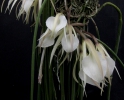|
|
|
|
|
| |
Flasks of
Brassavola acaulis 'Dorothy' × self |
|
| |
|
|
| |
|
|
Click to Enlarge

Pod Parent Flowers |
Click to Enlarge

Pod Parent Blooming Plant |
|
|
|
| |
Culture Notes from Donor: Parent plant: Temperature range I (60-83°F). Grows mounted on anything that will not rot. Cork, sassafras, log.
Comments: Parent plant: This Panamanian plant, when mature, can have its pendant leaves hang down two feet or more. Killer fragrance at night. Medium-sized plant.
For additional origin/habitat information supplied courtesy of
Charles and Margaret Baker, see further below, near the bottom of this page.
|
Temperatures we attempt to use in the lab & greenhouse:
| For Species: |
|
Spring, Summer, Autumn: days average 75°F, nights 58°F; best fit is Cool-Intermediate 75-58°F
(Source:
Baker's Web OSC) |
| For Species: |
|
Winter: days average 78°F, nights 55°F; best fit is Cool-Intermediate 75-58°F
(Source:
Baker's Web OSC) |
|
About the name...
| Etymology of |
acaulis |
|
From Latin "acaulis" stemless, with a low flower raceme.
(Source:
Mayr & Schmucker 1998) |
| Etymology of |
Brassavola |
|
Named for Antonio Musa Brassavola, nobleman and botanist of Venice during the 19th century.
(Source:
Pridgeon 1992) |
| Pronunciation of |
acaulis |
|
ah-KAW-lis
(Source:
Hawkes 1978) |
| Pronunciation of |
Brassavola |
|
bra-SAH-voe-la
(Source:
Pridgeon 1992) |
|
If you would like to direct someone to this web page, please copy and paste this URL into your email:
http://troymeyers.com/d?017916
| Flask Information |
| Availability: |
We have sold all of the flasks for this item. |
| You should: |
Consider getting individual plants or compots instead of a flask.
See if we have plants available in the greenhouse. |
| Yield Estimate: |
485 plants (based on flask surveys done 11/07/2014 through 07/28/2019)
|
| Plantlet Sizes: |
From many flasks 4 - 80 mm plants (based on flask surveys done 10/24/2015 through 03/09/2019)
From one most recently surveyed flask 15 - 80 mm (03/09/2019)
|
|
You might also want to:
|
View the seed assay for this item.
See if we have plants available in the greenhouse.
View items of the same species.
View items of the same genus.
|
| Ordering Information |
| You are not currently logged in. |
|
You must be a registered user and be logged in to reserve a flask or place a notification request. Please log in:
|
|
|
|
|
|
| |
The origin/habitat information below is supplied courtesy of Charles and Margaret Baker
The following information is based on the name of the plant provided by the donor, and assumes that the name is correct. If the plant has been misidentified, then the following information may not be correct.
This text is copyrighted by the Bakers and may not be reproduced without permission.
ORIGIN/HABITAT: Central America from Guatemala southward to Panama. In
Guatemala, these rare plants grow on trees in shady, damp places at
elevations up to 4250 ft. (1300 m). Dressler (1993) reports plants grow in
Costa Rica and Panama on the Pacific-facing lowlands at elevations to
about 3300 ft. (1000 m). Reports from Panama indicate plants grow in
Chiriquí Province at 3950 ft. (1200 m).
More about this information and the Bakers...
|
|
|
| |
|
|
|